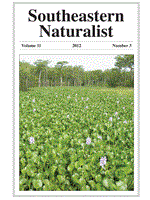Eichhornia crassipes (Waterhyacinth) occurs in isolated populations along the Waccamaw River in northeast South Carolina. Although actively managed with herbicides, plant biomass and growth in this coastal, blackwater river have not been measured. We located three persistent populations in protected backwaters during spring 2009 and used sequential harvests to measure biomass accumulation and allocation. Relative growth over one month in existing populations and in two downriver sites was measured by placing plants in floating cages. A separate experiment was conducted to determine salinity tolerance. Mean total biomass in the persistent populations was relatively low but increased from 202.9 g/m2 in spring to 380.1 g/m2 in fall, with leaves as the largest biomass component (72%). Absolute growth and leaf nutrient content for nitrogen, phosphorus, and potassium were highest for caged plants placed in a downriver site influenced by the Pee Dee River, a redwater system. Our results suggest that Waterhyacinth extent and growth in the Waccamaw River are limited by nutrient availability, but other factors may also be involved.
How to translate text using browser tools
1 September 2012
Biomass and Growth of Waterhyacinth in a Tidal Blackwater River, South Carolina
Amanda R. Rotella,
James O. Luken
ACCESS THE FULL ARTICLE

Southeastern Naturalist
Vol. 11 • No. 3
September 2012
Vol. 11 • No. 3
September 2012




